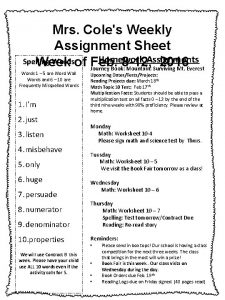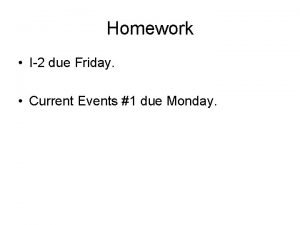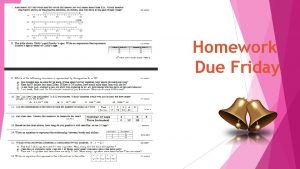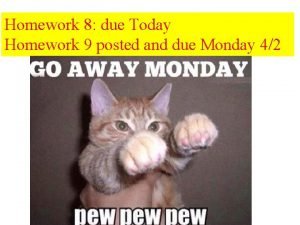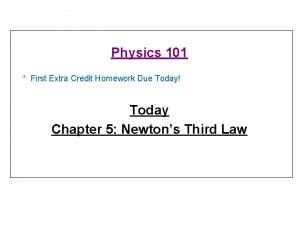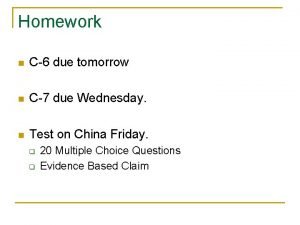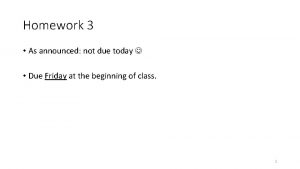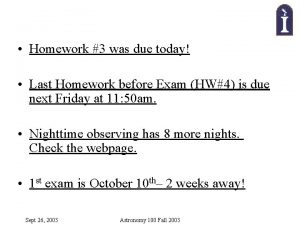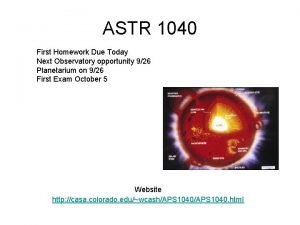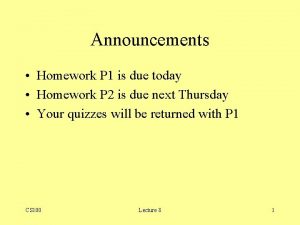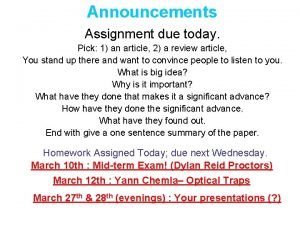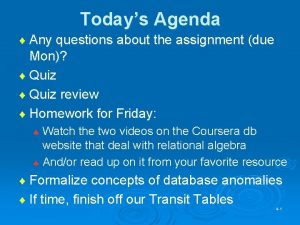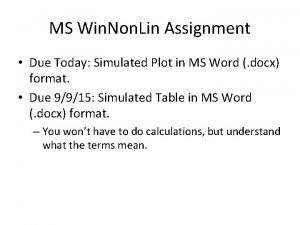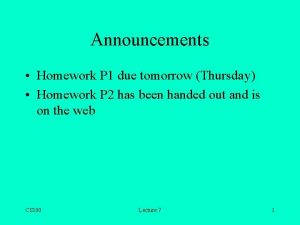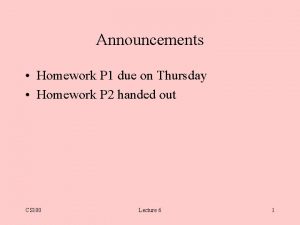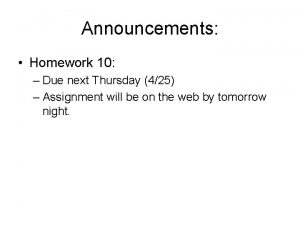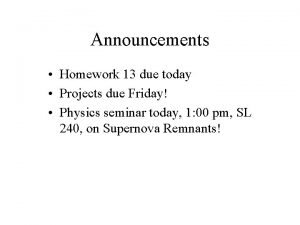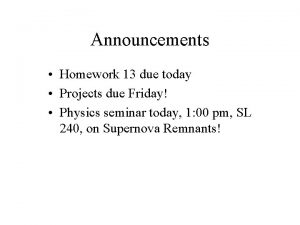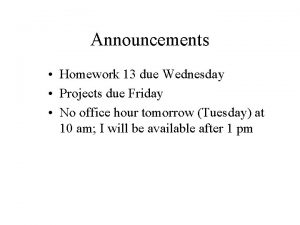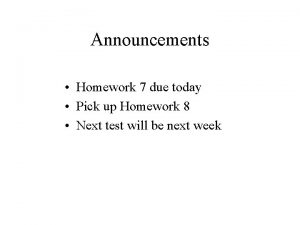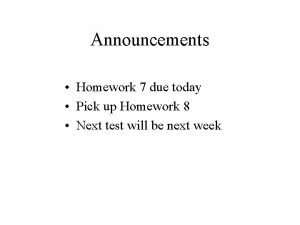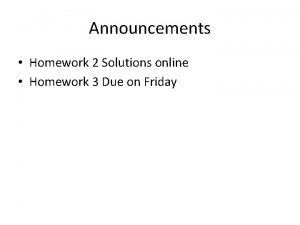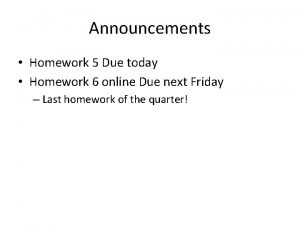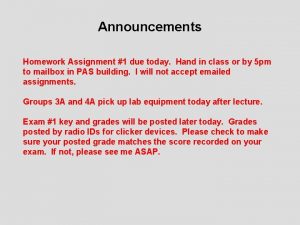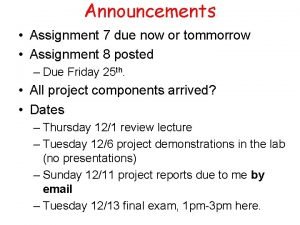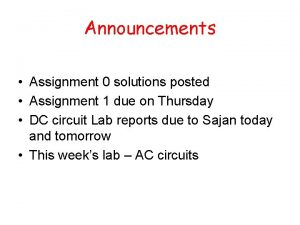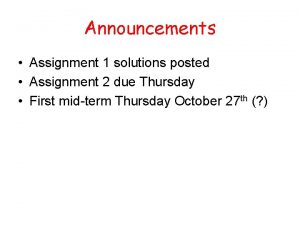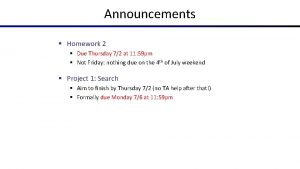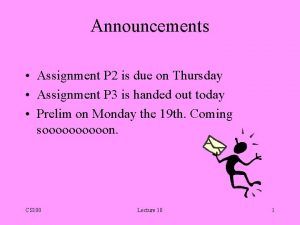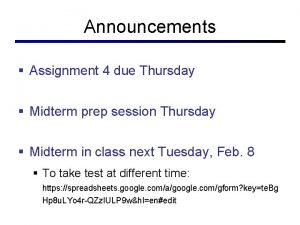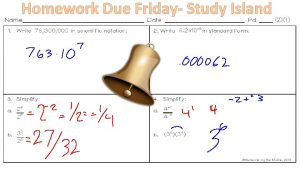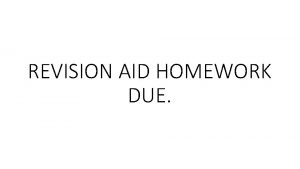Announcements First Homework Assignment Due Thursday 14 th



























- Slides: 27

Announcements • First Homework Assignment. • Due Thursday 14 th July, At start of class. • Complete pages 79 to 85 of the Lecture Tutorial book. • There are two sections to be complete. • The causes of the Moon Phases. • Predicting Moon Phases. • This is a double homework so each section will count as a separate homework. • First Mid-term test will be Friday 15 th July. • • It will cover everything we do up to and including Wed 13 th July. It is worth 10% of your grade. Based on in-class questions and lecture tutorial book questions. About 15 questions, 30 minutes long. Copyright © 2012 Pearson Education, Inc.

The Seasons Copyright © 2012 Pearson Education, Inc.

Thought Question Earth is closer to the Sun in summer and farther from the Sun in winter. A. True. B. False. Copyright © 2012 Pearson Education, Inc.

Thought Question Earth is closer to the Sun in summer and farther from the Sun in winter. A. True. B. False. Hint: During summer in the United States, it is winter in Australia. Copyright © 2012 Pearson Education, Inc.

Thought Question TRUE OR FALSE! Earth is closer to the Sun in summer and farther from the Sun in winter. • • • Variation of Earth–Sun distance is small—about 3%. This small variation is overwhelmed by the effects of axis tilt. Seasons are opposite in the N and S hemispheres. Days are longer during N summer and shorter during S winter. So changing distance from the sun cannot be the reason for the seasons. • The real reason for seasons involves Earth’s axis tilt. Copyright © 2012 Pearson Education, Inc.

Axis tilt changes directness of sunlight during the year. Why Does the Flux of Sunlight Vary Copyright © 2012 Pearson Education, Inc.

Summary: The Real Reason for Seasons • Earth’s axis points in the same direction (to Polaris) all year round, so its orientation relative to the Sun changes as Earth orbits the Sun. • Summer occurs in your hemisphere when sunlight hits it more directly; winter occurs when the sunlight is less direct. • Days are longer in Summer, this also means more sunlight in Summer. • AXIS TILT is the key to the seasons; without it, we would not have seasons on Earth. Copyright © 2012 Pearson Education, Inc.

How do we mark the progression of the seasons? • We define four special points: summer solstice winter solstice spring (vernal) equinox fall (autumnal) equinox Copyright © 2012 Pearson Education, Inc.

We can recognize solstices and equinoxes by the Sun’s path across the sky. Summer solstice: Highest path, rise and set at most extreme north of due east Winter solstice: Lowest path, rise and set at most extreme south of due east Equinoxes: Sun rises precisely due east and sets precisely due west. Copyright © 2012 Pearson Education, Inc.

Seasonal changes are more extreme at high latitudes. Path of the Sun on the summer solstice at the Arctic Circle Copyright © 2012 Pearson Education, Inc.

Phases of the Moon. Copyright © 2012 Pearson Education, Inc.

Why do we see phases of the Moon? • Lunar phases are a consequence of the Moon’s 27. 3 -day orbit around Earth. Copyright © 2012 Pearson Education, Inc.

Phases of the Moon • Half of the Moon is illuminated by the Sun and half is dark. • We see a changing combination of the bright and dark faces as the Moon orbits Earth. Copyright © 2012 Pearson Education, Inc.

Phases of the Moon Copyright © 2012 Pearson Education, Inc.

Moon Rise/Set by Phase Time the Moon Rises and Sets for Different Phases Copyright © 2012 Pearson Education, Inc.

Phases of the Moon: 29. 5 -day cycle new crescent first quarter gibbous full gibbous last quarter crescent Copyright © 2012 Pearson Education, Inc. } } waxing • Moon visible in afternoon/evening • Gets “fuller” and rises later each day waning • Moon visible in late night/morning • Gets “less” and sets later each day

Thought Question It’s 9 A. M. You look up in the sky and see a moon with half its face bright and half dark. What phase is it? A. B. C. D. first quarter waxing gibbous third quarter half moon Copyright © 2012 Pearson Education, Inc.

We see only one side of the Moon. Synchronous rotation: The Moon rotates exactly once with each orbit. This is why only one side is visible from Earth. Copyright © 2012 Pearson Education, Inc.

What causes eclipses? • The Earth and Moon cast shadows. • When either passes through the other’s shadow, we have an eclipse. Copyright © 2012 Pearson Education, Inc.

The Cause Of Eclipses Copyright © 2012 Pearson Education, Inc.

Lunar Eclipse Copyright © 2012 Pearson Education, Inc.

When can eclipses occur? • Lunar eclipses can occur only at full moon. • Lunar eclipses can be penumbral, partial, or total. Copyright © 2012 Pearson Education, Inc.

Solar Eclipse Evolution of a Total Solar Eclipse Copyright © 2012 Pearson Education, Inc.

When can eclipses occur? • Solar eclipses can occur only at new moon. • Solar eclipses can be partial, total, or annular. Copyright © 2012 Pearson Education, Inc.

Why don’t we have an eclipse at every new and full moon? — The Moon’s orbit is tilted 5° to the ecliptic plane. — So we have about two eclipse seasons each year, with a lunar eclipse at new moon and solar eclipse at full moon. Copyright © 2012 Pearson Education, Inc.

Summary: Two conditions must be met to have an eclipse 1. It must be a full moon (for a lunar eclipse) or a new moon (for a solar eclipse). AND 2. The Moon must be at or near one of the two points in its orbit where it crosses the ecliptic plane (its nodes). Copyright © 2012 Pearson Education, Inc.

• Now work on the tutorial Booklet … Page 91 -96 Copyright © 2012 Pearson Education, Inc.
 Pvu official announcement
Pvu official announcement R/announcements!
R/announcements! Church announcements
Church announcements Page 113 of fahrenheit 451
Page 113 of fahrenheit 451 Kayl announcements
Kayl announcements General announcements
General announcements Homework oh homework i hate you you stink
Homework oh homework i hate you you stink Homework oh homework i hate you you stink
Homework oh homework i hate you you stink Parts of a poem
Parts of a poem Homework i love you poem
Homework i love you poem Alitteration definition
Alitteration definition Literal language example
Literal language example Flow diagram homework assignment
Flow diagram homework assignment Weekly homework assignment sheet
Weekly homework assignment sheet Folk culture and popular culture venn diagram
Folk culture and popular culture venn diagram Homework is due on friday
Homework is due on friday Homework is due on friday
Homework is due on friday Black cat analogy
Black cat analogy Homework due today
Homework due today Ilegalism
Ilegalism Homework due today
Homework due today Homework is due
Homework is due 3 weeks from today
3 weeks from today Homework due today
Homework due today Homework due today
Homework due today Assignment due today
Assignment due today Assignment due today
Assignment due today Assignment due today
Assignment due today













